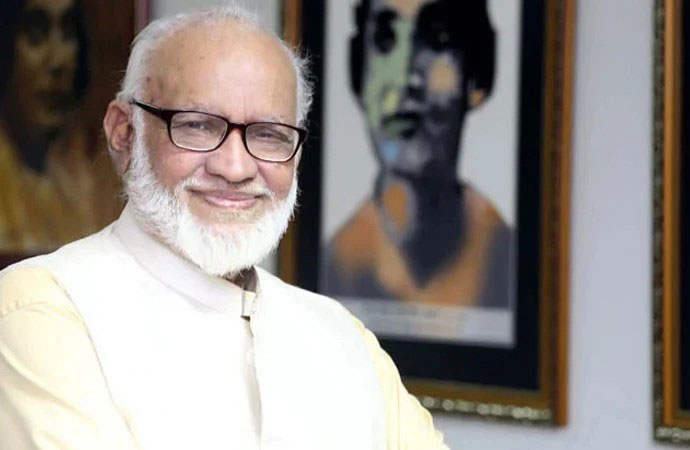Technology



























Photo: NASA, ESA, CSA, and STScI via AP/UNB
A sparkling landscape of baby stars. A foamy blue and orange view of a dying star. Five galaxies in a cosmic dance. The splendours of the universe in all its glory glowed in a new batch of images released Tuesday from NASA's powerful new telescope.
The unveiling from the $10 billion James Webb Space Telescope began Monday (Jul. 11) at the White House with a sneak peek of the first shot - a jumble of distant galaxies that went deeper into the cosmos than humanity has ever seen. This week's releases showed parts of the universe seen by other telescopes. But Webb's sheer power, distant location from Earth and use of the infrared light spectrum showed them in a new light that scientists said was almost as much art as science.
"It's the beauty but also the story," NASA senior Webb scientist John Mather, a Nobel laureate, said after the reveal. "It's the story of where did we come from."
And, he said, the more he looked at the images, the more he became convinced that life exists elsewhere in those thousands of stars and hundreds of galaxies.
With Webb, scientists hope to glimpse light from the first stars and galaxies that formed 13.7 billion years ago, just 100 million years from the universe-creating Big Bang. The telescope also will scan the atmospheres of alien worlds for possible signs of life.
"Every image is a new discovery and each will give humanity a view of the humanity that we've never seen before," NASA Administrator Bill Nelson said Tuesday (Jul. 13), rhapsodising over images showing "the formation of stars, devouring black holes."
Webb's use of the infrared light spectrum allows the telescope to see through the cosmic dust and see faraway light from the corners of the universe, scientists said.
"We've really changed the understanding of our universe," said European Space Agency director general Josef Aschbacher.
The European and Canadian space agencies joined NASA in building the telescope, which was launched in December after years of delays and cost overruns. Webb is considered the successor to the highly successful, but ageing Hubble Space Telescope.
Some of Hubble's most stunning images have been shots of the Carina nebula, one of the bright stellar nurseries in the sky, about 7,600 light-years away. Webb project scientist Klaus Pontoppidan decided to focus one of Webb's early gazes on that location because he knew it would be the frameable beauty shot. The result was an image of a colourful landscape of bubbles and cavities where stars were being born.
"This is art," Pontoppidan said. "I really wanted to have that landscape. It has that contrast. We have the blue. We have golden. There's dark. There's bright. There's just a sharp image."
Also among the new shots
- Southern Ring nebula, which is sometimes called "eight-burst." Images show a dying star with a foamy edge of escaping gas. It's about 2,500 light-years away. A light-year is 5.8 trillion miles. "This is the end for this star, but the beginning for other stars," Pontoppidan said. As it dies, it throws off parts that seed the galaxy with elements used for new stars, he said.
-- Stephan's Quintet, five galaxies in a cosmic dance that was first seen 225 years ago in the constellation Pegasus. It includes a black hole that scientists said showed material "swallowed by this sort of cosmic monster." Webb "has just given us a new, unprecedented 290 million-year-old view of what this Quintet is up to," Cornell University astronomer Lisa Kaltenegger, who wasn't part of the Webb team, said in an email.
- A giant planet called WASP-96b. It's about the size of Saturn and is 1,150 light-years away. A gas planet, it's not a candidate for life elsewhere but a key target for astronomers. Instead of an image, the telescope used its infrared detectors to look at the chemical composition of the planet's atmosphere. It showed water vapour in the super-hot planet's atmosphere and even found the chemical spectrum of neon, showing clouds where astronomers thought there were none.
The images were released one-by-one at an event at NASA's Goddard Space Center that included cheerleaders with pompoms the colour of the telescope's golden mirrors.
"It moves you. This is so, so beautiful," Thomas Zurbuchen, chief of NASA's science missions, said after the event. "Nature is beautiful. To me this is about beauty."
The world's biggest and most powerful space telescope rocketed away last December from French Guiana in South America. It reached its lookout point 1 million miles (1.6 million kilometres) from Earth in January. Then the lengthy process began to align the mirrors, get the infrared detectors cold enough to operate and calibrate the science instruments, all protected by a sunshade the size of a tennis court.
The First Deep Field
Thousands of galaxies flood the near-infrared image of galaxy cluster SMACS 0723. High-resolution imaging from NASA's James Webb Space Telescope combined with a natural effect known as gravitational lensing made the finely detailed image possible.
First, focus on the galaxies responsible for the lensing: the bright white elliptical galaxy at the centre of the image and smaller white galaxies throughout the image. Bound together by gravity in a galaxy cluster, they are bending the light from galaxies that appear in the vast distances behind them. The combined mass of the galaxies and dark matter act as a cosmic telescope, creating magnified, contorted, and sometimes mirrored images of individual galaxies.
Clear examples of mirroring are found in the prominent orange arcs to the left and right of the brightest cluster galaxy. These are lensed galaxies - each individual galaxy is shown twice in one arc. Webb's image has fully revealed their bright cores, which are filled with stars, along with orange star clusters along their edges.
Not all galaxies in this field are mirrored - some are stretched. Others appear scattered by interactions with other galaxies, leaving trails of stars behind them.
Webb has refined the level of detail we can observe throughout this field. Very diffuse galaxies appear like collections of loosely bound dandelion seeds aloft in a breeze. Individual "pods" of star formation practically bloom within some of the most distant galaxies - the clearest, most detailed views of star clusters in the early universe so far.
One galaxy speckled with star clusters appears near the bottom end of the bright central star's vertical diffraction spike - just to the right of a long orange arc. The long, thin ladybug-like galaxy is flecked with pockets of star formation. Draw a line between its "wings" to roughly match up its star clusters, mirrored top to bottom. Because this galaxy is so magnified and its individual star clusters are so crisp, researchers will be able to study it in exquisite detail, which wasn't previously possible for galaxies this distant.
The galaxies in this scene that are farthest away - the tiniest galaxies that are located well behind the cluster - look nothing like the spiral and elliptical galaxies observed in the local universe. They are much clumpier and more irregular. Webb's highly detailed image may help researchers measure the ages and masses of star clusters within these distant galaxies. This might lead to more accurate models of galaxies that existed at cosmic "spring," when galaxies were sprouting tiny "buds" of new growth, actively interacting and merging, and had yet to develop into larger spirals. Ultimately, Webb's upcoming observations will help astronomers better understand how galaxies form and grow in the early universe.
Cosmic Cliffs in Carina
The seemingly three-dimensional "Cosmic Cliffs" showcases Webb's capabilities to peer through obscuring dust and shed new light on how stars form. Webb reveals emerging stellar nurseries and individual stars that are completely hidden in visible-light pictures. This landscape of "mountains" and "valleys" is actually the edge of a nearby stellar nursery called NGC 3324 at the northwest corner of the Carina Nebula.
So-called mountains - some towering about 7 light-years high - are speckled with glittering, young stars imaged in infrared light. A cavernous area has been carved from the nebula by the intense ultraviolet radiation and stellar winds from extremely massive, hot, young stars located above the area shown in this image. The blistering, ultraviolet radiation from these stars is sculpting the nebula's wall by slowly eroding it away. Dramatic pillars rise above the glowing wall of gas, resisting this radiation. The "steam" that appears to rise from the celestial "mountains" is actually hot, ionized gas and hot dust streaming away from the nebula due to the relentless radiation.
Objects in the earliest, rapid phases of star formation are difficult to capture, but Webb's extreme sensitivity, spatial resolution and imaging capability can chronicle these elusive events.
This landscape of "mountains" and "valleys" speckled with glittering stars is actually the edge of a nearby, young, star-forming region called NGC 3324 in the Carina Nebula. Captured in infrared light by NASA's new James Webb Space Telescope, this image reveals for the first time previously invisible areas of star birth.
Called the Cosmic Cliffs, Webb's seemingly three-dimensional picture looks like craggy mountains on a moonlit evening. In reality, it is the edge of the giant, gaseous cavity within NGC 3324, and the tallest "peaks" in this image are about 7 light-years high. The cavernous area has been carved from the nebula by the intense ultraviolet radiation and stellar winds from extremely massive, hot, young stars located in the centre of the bubble, above the area shown in this image.
The blistering, ultraviolet radiation from the young stars is sculpting the nebula's wall by slowly eroding it away. Dramatic pillars tower above the glowing wall of gas, resisting this radiation. The "steam" that appears to rise from the celestial "mountains" is actually hot, ionized gas and hot dust streaming away from the nebula due to the relentless radiation.
Webb reveals emerging stellar nurseries and individual stars that are completely hidden in visible-light pictures. Because of Webb's sensitivity to infrared light, it can peer through cosmic dust to see these objects. Protostellar jets, which emerge clearly in this image, shoot out from some of these young stars. The youngest sources appear as red dots in the dark, dusty region of the cloud. Objects in the earliest, rapid phases of star formation are difficult to capture, but Webb's extreme sensitivity, spatial resolution, and imaging capability can chronicle these elusive events.
These observations of NGC 3324 will shed light on the process of star formation. Star birth propagates over time, triggered by the expansion of the eroding cavity. As the bright, ionized rim moves into the nebula, it slowly pushes into the gas and dust. If the rim encounters any unstable material, the increased pressure will trigger the material to collapse and form new stars.
Conversely, this type of disturbance may also prevent star formation as the star-making material is eroded away. This is a very delicate balance between sparking star formation and stopping it. Webb will address some of the great, open questions of modern astrophysics: What determines the number of stars that form in a certain region? Why do stars form with a certain mass?
Webb will also reveal the impact of star formation on the evolution of gigantic clouds of gas and dust. While the effect of massive stars - with their violent winds and high energy - is often apparent, less is known about the influence of the more numerous low-mass stars. As they form, these smaller stars create narrow, opposing jets seen here, which can inject a lot of momentum and energy into the clouds. This reduces the fraction of nebular material that seeds new stars.
Up to this point, scientists have had very little data about the influence of the multitude of young and more energetic low-mass stars. With Webb, they will be able to obtain a full census of their number and impact throughout the nebula.
Located roughly 7,600 light-years away, NGC 3324 was imaged by Webb's Near-Infrared Camera (NIRCam) and Mid-Infrared Instrument (MIRI).
NIRCam - with its crisp resolution and unparalleled sensitivity - unveils hundreds of previously hidden stars, and even numerous background galaxies.
In MIRI's view, young stars and their dusty, planet-forming disks shine brightly in the mid-infrared, appearing pink and red. MIRI reveals structures that are embedded in the dust and uncovers the stellar sources of massive jets and outflows. With MIRI, the hot dust, hydrocarbons and other chemical compounds on the surface of the ridges glow, giving the appearance of jagged rocks.
NGC 3324 was first catalogued by James Dunlop in 1826. Visible from the Southern Hemisphere, it is located at the northwest corner of the Carina Nebula (NGC 3372), which resides in the constellation Carina. The Carina Nebula is home to the Keyhole Nebula and the active, unstable supergiant star called Eta Carinae.
A Cosmic Cluster: Stephan's Quintet
The JWST team also released never-before-seen details of the galaxy group called "Stephan's Quintet." The close proximity of this group gives astronomers a ringside seat to galactic mergers and interactions. Rarely do scientists see in so much detail how interacting galaxies trigger star formation in each other, and how the gas in these galaxies is being disturbed.
Stephan's Quintet is a fantastic "laboratory" for studying these processes fundamental to all galaxies. The image also shows outflows driven by a supermassive black hole in one of the group's galaxies in a level of detail never seen before. Tight galaxy groups like this may have been more common in the early universe when superheated, infalling material may have fueled very energetic black holes.
Together, the five galaxies of Stephan's Quintet are also known as the Hickson Compact Group 92 (HCG 92). Although called a "quintet," only four of the galaxies are truly close together and caught up in a cosmic dance. The fifth and leftmost galaxy, called NGC 7320, is well in the foreground compared with the other four. NGC 7320 resides 40 million light-years from Earth, while the other four galaxies (NGC 7317, NGC 7318A, NGC 7318B, and NGC 7319) are about 290 million light-years away. This is still fairly close in cosmic terms, compared with more distant galaxies billions of light-years away. Studying such relatively nearby galaxies like these helps scientists better understand structures seen in a much more distant universe.
Located in the constellation Pegasus, Stephan's Quintet was discovered by the French astronomer Édouard Stephan in 1877.
The dying stars' dance
JWST has cast the Southern Ring Nebula in an entirely new light. By observing the nebula in mid-infrared wavelengths, Webb has unveiled the second, dusty star at the centre of the nebula in far more detail. The star closely orbits its companion as it periodically ejects layers of gas and dust. Together, the swirling duo have created a fantastic landscape of asymmetrical shells.
The dimmer star at the centre of this scene has been sending out rings of gas and dust for thousands of years in all directions, and JWST has revealed for the first time that this star is cloaked in dust.
Two cameras aboard Webb captured the latest image of this planetary nebula, catalogued as NGC 3132, and known informally as the Southern Ring Nebula. It is approximately 2,500 light-years away.
Webb will allow astronomers to dig into many more specifics about planetary nebulae like this one - clouds of gas and dust expelled by dying stars. Understanding which molecules are present, and where they lie throughout the shells of gas and dust will help researchers refine their knowledge of these objects.
Two stars, which are locked in a tight orbit, shape the local landscape. Webb's infrared images feature new details in this complex system. The stars - and their layers of light - are prominent in the image from Webb's Near-Infrared Camera (NIRCam) on the left, while the image from Webb's Mid-Infrared Instrument (MIRI) on the right shows for the first time that the second star is surrounded by dust. The brighter star is in an earlier stage of its stellar evolution and will probably eject its own planetary nebula in the future.
In the meantime, the brighter star influences the nebula's appearance. As the pair continues to orbit one another, they "stir the pot" of gas and dust, causing asymmetrical patterns.
How does Webb see back in time?
Telescopes can be time machines. Looking out in space is like looking back in time. It sounds magical, but it's actually very simple: Light needs time to travel across the vast distances of space to reach us.
Light waves move extremely fast, about 186,000 miles (300,000 km) per second, every second. Light moves so fast that as we go about our daily lives, it appears to travel instantaneously from one place to another. For example, it takes only a few billionths of a second for light to travel across a room once a lamp is switched on.
In space, however, the distances are so immense that the time light takes to travel is noticeable.
The Moon is Earth's closest companion, at about 239,000 miles (390,000 km) away. Light takes around 1.3 seconds to travel the distance to Earth. When we look up at the sky, we see the Moon as it was 1.3 seconds earlier.
Similarly, light from the planet Neptune takes about four hours to cross the solar system, so we say Neptune is four light-hours away.
Travelling Light
Across our Milky Way galaxy, distances are measured in terms of how many years it takes light to travel. The nearest star is over four light-years away. So when we look at that nearest star, we see it not as it is today, but as it was four years ago. We are seeing the light that left that star four years previously and is just reaching us now.
Galaxies are yet farther away in both space and time. Our nearest large neighbour galaxy, Andromeda, is about two-and-a-half million light-years away. The Virgo Cluster of galaxies is the largest nearby collection of galaxies, at about 60 million light-years from the Milky Way. The light we see today from galaxies in the Virgo Cluster started on its path toward us at the same time as the age of the dinosaurs was ending on Earth. If you were in a Virgo Cluster galaxy today, and you had a telescope powerful enough to study the Earth, you would be able to see the prehistoric reptiles.
Additional Reporting by AP, Space Telescope Science Institute, NASA

























Leave a Comment
Recent Posts
Spice Girls
Spice Girls was a British pop band. Spice Girls included: Victoria Bec ...
South Korea Is Facing a Triple ...
Few countries have transformed themselves as dramatically as South Kor ...
Kazi Shahidullah bahi and the DU: From a memorial me ..
France-Bangladesh cooperation in focus at ‘Strategic ..
Indian president hopes for ‘democratic, inclusive’ B ..
The botched restructuring of NBR bodes ill for the r ..